In this article we will cover the basics of why and how to use Google Ads in travel industry.
We won’t go into details but you can get on them if you follow the links provided in this article.
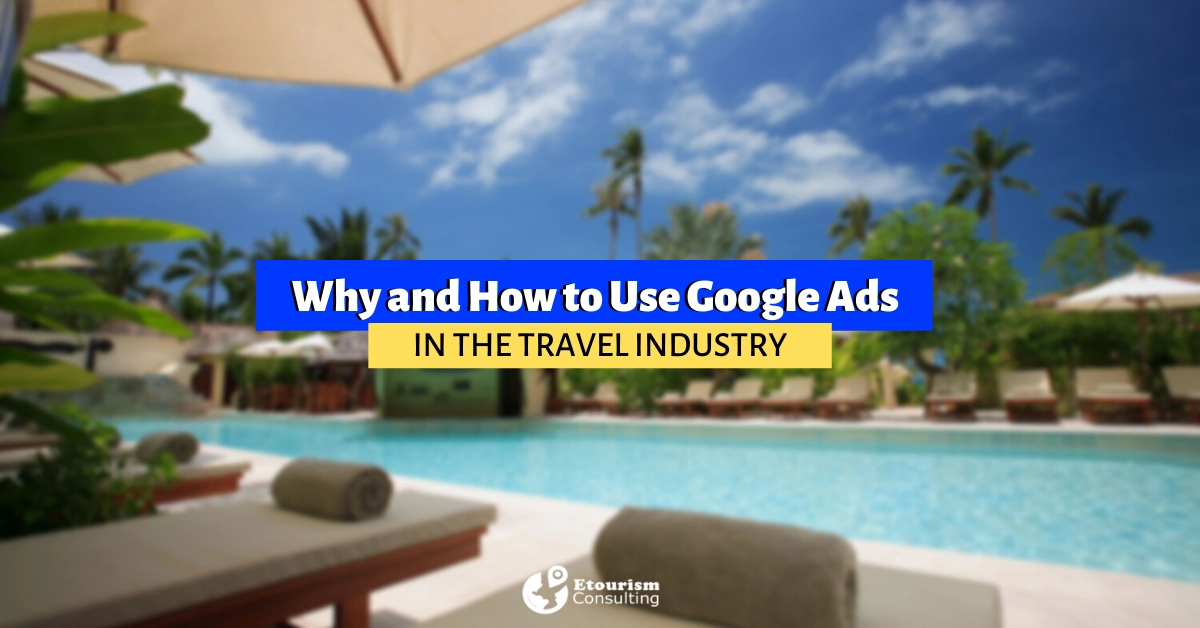
To put it briefly, Google Ads (formerly known as Google Adwords) is paid Google advertising, which can help you get more guests and sell more tours, as you will put yourself on the first page of Google search results for the keywords you choose and appear on many other adequate websites.
Paid advertising on the Internet gives you the possibility to show your ad only to those people who are the most interested in your offer – your target group.
The greatest advantage of AdWords is that your offer is shown at the same moment when the tourist actively searches for it.
Let’s say that someone searches ‘accommodation in Chamonix’ on Google.
If they know how to take advantage of the situation, hoteliers and owners of accommodation will post their ad which will be immediately shown at the top of the search in a much similar way as the other organic (non-paid) search results.
Here’s how it looks like:
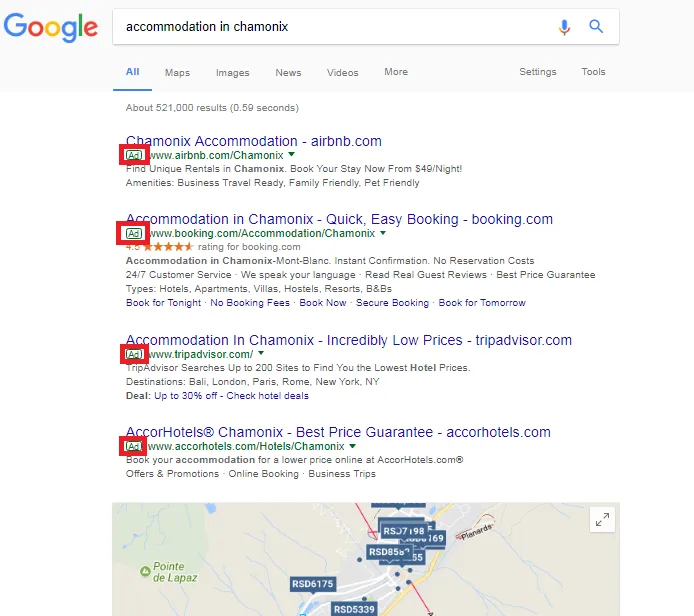
If you closely look at the image above, you’ll notice that even first four search results are, actually, paid ads and that only 5th search result is the usual organic first search, and it would be the first search if there was no one to advertise for this search phrase.
That’s right, Google Ads gives you the possibility to be the first on Google, and all that at the same moment when a tourist is looking for the exact thing you offer!
You can follow whether these people clicked on your ad, how many of them have seen the ad at all, and if you are more skillful, you can even see who made the reservation.
You can advertise on any device, PC, tablet and cell phone.
1. Advantages of using Google Ads in tourism and hospitality
Google Ads gives you the possibility to take advantage of all the good sides of online marketing, showing your ad to the right people, at the right place and right time. Using Google Ads in travel marketing offer many benefits, and these are the key ones:
Targeting – find your target group!
Targeting is the process of selecting your target group according to their specific interests and characteristics and who are potentially the most interested in your offer, so you need to show them an ad.
The basic pre-condition of a successful targeting is that you know your target group well and that you already have profiles of your ‘ideal guests’.
You cannot have an offer for everyone, you need to think thoroughly about the people who will see the ad, who will see what you offer and who will be the most interested ones.
Make a few profiles of people who belong to your target group and write everything about them – where they live, where they work, how old they are, their gender, their salaries, their affinities, what they like and don’t like, what brands do they prefer, what websites they visit, and apps they use, and so on.
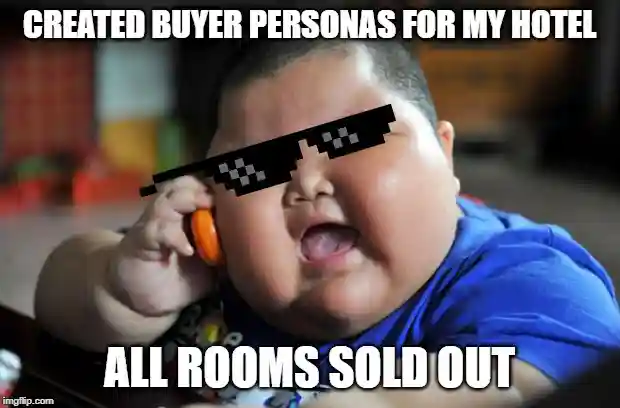
With AdWords, you can target travelers by:
– Keywords – Surely the greatest advantage and strength of AdWords! You can show your ad only to people who search some particular keyword on Google or on some other relevant partner websites.
For instance: if you own an apartment in Verona, you can show your ad to those people who are looking for the following words on Google: “apartment Verona”, “accommodation Verona”, “accommodation in Verona”, “overnight in Verona”, “rooms in Verona” and you can try “hotel in Verona” and so on.
– Ad location – You can set whether your ad will be shown in the Google search results, on commercial websites or personal blogs;
– Age, location, and language: choose your target group according to their age, location and language they speak;
– Day, time and frequency: Show your ad only during the particular hours during a day, or during the particular days in a week, and decide on the frequency of the appearance of your ad;
– Devices: decide whether your ad will be shown on all devices or maybe just to the cell phone users;
You set the budget
Google Ads gives you the possibility to set the budget for advertising on your own.
There aren’t any lower limits for the payment!
And you can decide how much money you’ll spend monthly, daily or by ad and campaign. And last, but not the least important fact: you don’t pay when someone sees your ad, only when someone clicks on it!
Follow the efficiency and optimize your campaigns
You will be notified every time someone clicks on your ad.
Also, you can follow what these people did after clicking on an ad – whether they made reservations, downloaded your brochure or catalog, or whether they applied to your newsletter.
You can see which of your ads gets the most clicks, which keywords are better for the visitors, and which are not.
That’s how you’ll know in what way to manage your budget and further investments. Logically enough: you’ll invest in these keywords which bring you more bookings (or whatever you want).
After some time, you can calculate how much, on average one booking received by the use of Google Ads costs you, and whether this is profitable for you. Moreover, you can get the proximity of that price prior to setting the ad, using the tool Google Keyword Planner.
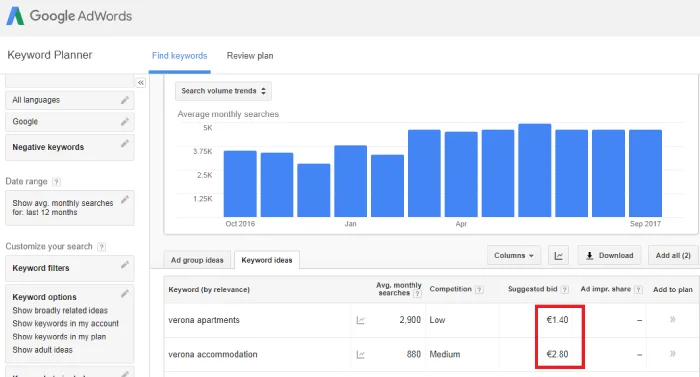
Here is one simple example for measuring the success of AdWords campaign:
This is easy to estimate.
Let’s say you own an apartment and you offer the night stay which costs €45 per person.
Many people, who comprise your target group, can see the ad through the various keywords that you used when creating the ad. Let’s say that one click per ad costs you €1.80 (it can be both more and less than this, depending on the contenders), and 100 people click on your ad.
This will mean that you will get 100 people, who comprise your target group on your website, and that you will spend €180.
However, even when you gather your target group on the website, you should know that you can expect only 2% conversions, that is, two bookings, on average.
The worst scenario, in this case, would be that both bookings are for one person only and for one night only, where you’ll get an income of 2×45= 90€, which is less then you have invested and the financial outcome won’t be positive for you.
But if those two bookings are made for 6 people and for 2 nights, you will have 6x2x45= 540€ and with this scenario, you will gain a lot more than you have invested.
Can you imagine these being the bookings for four-people families, one for a weekend, and another one for 7 days?
2. Google advertising networks
Advertising with AdWords gives you the possibility to show your ads on both Google’s advertising networks:
- Google Search Network – advertising in the search results and partner websites and
- Google Display Network – visual advertisement by banners on different websites across the web.
Google Search Network
This network includes advertising in the Google search results, as well as on the other Google services, like Google Maps or Gmail, and on thousands of other websites which are Google’s partners and show ads which are relevant to the keywords.
Advertising through Google Search Network enables you to:
- put your offer in front of your guests when they are searching for it
- show textual ads to the potential guests in Google search results
- find potential tourists who search for the specific package tours or hotels while looking for the specific package tours on the Internet.
Google Display Network
This network includes the collection of websites and services owned by Google (Blogger, Gmail, and YouTube), the partner websites and mobile apps which are in the network.
Advertising in this network enables you to:
- Use attractive visual solutions to reach your audience;
- Build your audience’s awareness about the existence of your destination/tour/hotel, for brand developing and creating loyalty with your guests;
- Increase the number of visitors on your website;
- Choose where your ads will be placed and to what type of audience (it is necessary for you to know your audience very well).
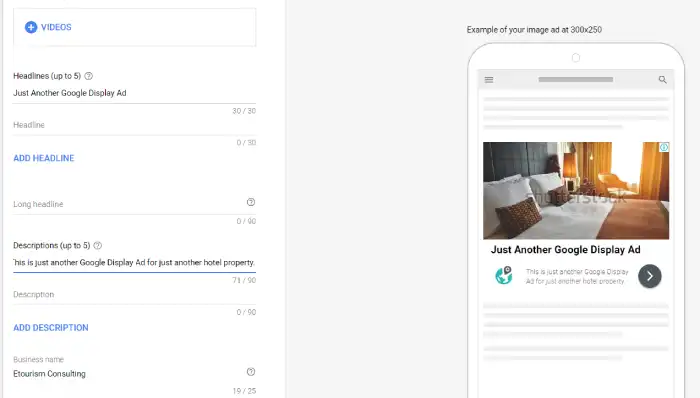
In order to understand how Google Ads functions, first you need to get acquainted with some basic things: where your ads can be shown, the ad quality, and how much you pay for advertising.
If you need any help with Google Ads advertising, do not hesitate to contact us.
3. Where will your ads appear?
As it has already been said, your ads can appear on many different websites on the Internet, depending on the way you target your group and the type of ads you create.
Google Search Network
First of all, you need to understand the Keywords.
The keyword is a word or a phrase which describes your offer or a service with which you’ll target your audience. When someone searches something similar or identical to your chosen keyword on Google – your ad can appear over or next to the regular (organic) results.
An example:
If you are selling package tours for Thasos (island) in Greece, you would want that your offer for this island to appear when someone types in Google search “Thasos summer vacation”, “summer vacation on Thasos”, “package tour for Thasos”, and so on. These are the keywords which will bring you first place in Google search and for which you will pay Google Ads advertising in order to appear next to the regular search results.
Keywords also help you in deciding what price to pay the advertising. For each keyword, you can set Maximum cost-per-click (max. CPC) price, that is, the highest price you are willing to pay for one click on your ad which is shown when someone searches for that keyword.
It’s important to know that there are two possible formats of your ad:
- Text Ads – The simplest and the most frequent form of an ad for Google Search Network. This ad consists of a title, URL address of your website and description.
- Ads with extensions– The possibility to add some more information to your ad, such as telephone number, location, working hours, links to the different parts of your website, and so on. Having in mind that the number of characters in the title and in the description of an ad limited, this is a good possibility to add some significant information to your advertisement, the ones that you want the tourists to see, and in this way, make your ad visually attractive. Have in mind that using the extensions will also improve the quality score for your ads, which means you will get lower CPC (Cost per Click), or simply put – you will get more for your money!
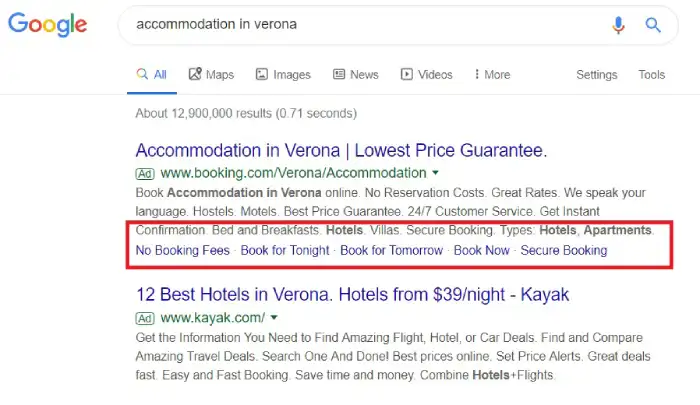
You can choose where exactly on the Internet your ad will appear. An ad can be shown only on partners’ websites of your choice or on websites which content matches the targeting you set: keywords, ad location, audience or specific topics and areas.
If you do targeting by keywords, your ad will be shown on websites the content of which matches your target words.
AN EXAMPLE:
If you are offering walking and mountain hiking tours in Chamonix, you will set the following keywords for the campaign: “mountain hiking tours Chamonix”, “walking tour Chamonix” and so on.
Besides being shown in the Google search results when someone searches these keywords, your ad can be shown on the websites which business is about mountain hiking, alpinism blogs about mountains, alpinism forums, pages about Chamonix and other websites which are partnered with Google.
For this functionality, you will have to select Search Network with Display Select type when creating your campaign.
So, Google automatically recognizes and sets the partner websites where your ad will be shown, and you can also choose the websites where your ad will be shown.
If you publish your ads through Display advertisement network, you have the possibility to show them to the specific groups of people which you can segment according to their interests, age or gender, or to the ones who have already visited your website.
On Display network, you can publish your ads in the following formats:
- Text Ad
- Image Ad
- Responsive Ad
- Video Ad
Appearance of your ad on mobiles
It is well-known that tourists increasingly use the Internet on tablets and smartphones, and while surfing the Internet, they look for the idea for their next weekend trip.
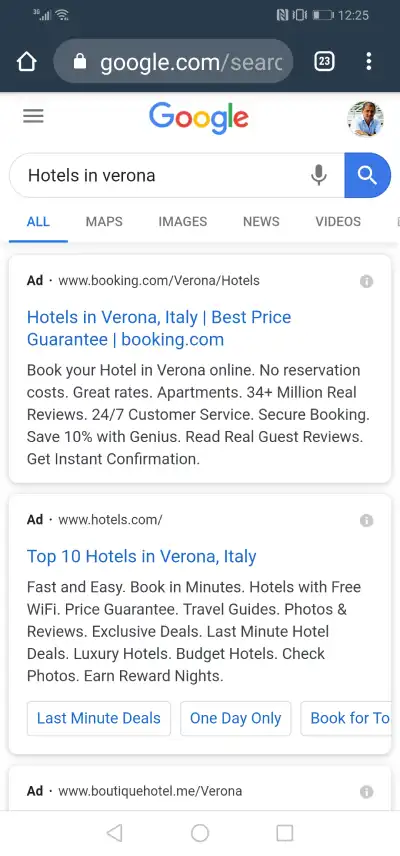
Your ad can appear in the following way:
- Textual ad which appears in Google search results to users with mobile devices
- Text, an image or a video which appears on Display network on partner websites which potential tourist visit on their cell phones.
4. Ad quality
High-quality ads can bring you lower costs of advertising, better positions of your ads and higher efficiency of advertising, that is, a higher number of guests and tourists at a lower rate.
First of all, you need to have in mind the basic function of Google – to show to its users the best possible results for their search queries.
The same goes for the paid ads.
If you paid an ad for the particular keyword and the traveler didn’t get a good search result for this keyword, you need to pay more, or a lot, and maybe your ad won’t be shown at all.
However, if you have a high-quality ad, you will pay less, and get more.
Google sets the ad quality by Quality Score, which consists of:
CTR – click-through rate
CTR represents the expected number of clicks per ad. Google estimates how many people will click on your ad, based on the experience of millions of users. The higher CTR, the better.
Ad relevance
Google estimates whether your ad is relevant enough and whether it is a good search result for the users.
If you are setting an ad for the keyword “Verona accommodation” and you don’t mention Verona at all in the title and description, or you direct the users to a landing page that is not much connected to accommodation in Verona, you cannot expect that you will have a good relevance score.
Also, pay attention to the language in which the keyword is written, the language of an ad, and of landing page.
So, the higher the ad relevance for the particular keyword, the higher Quality Score of an ad.
Landing page quality
Landing pages are very important, not only for Google Ads but also for your overall online marketing strategy.
To put it briefly, the landing page is a page which opens after a user clicks on your ad.
Landing page needs to be fast on loading, easy to navigate and use, to contain relevant information which you mentioned in your ad and to be in the adequate language. If you have put an ad with the keyword “accommodation in Verona” it won’t be good to set landing page in French, or in Italian, it just has to be in English. If you have set an ad for “‘attractions in Verona”, don’t set the booking page as your landing page because people are expecting to see a relevant landing page with famous landmarks and places to visit.
So, these three components comprise Quality Score of your ad. You’ll get Quality Score for each keyword, on the scale from 1 to 10.

The more relevant your ads and landing pages to the users are, the higher Quality Score of your ad you will get and you will pay less CPC (Cost Per Click), that is, the rate per one click and your ad will be shown more frequently even above the contenders, and you will have better Ad Rank.
OK, what the hell is Ad Rank?
While Quality Score determines your ad quality, Ad Rank shows you the ranking of your ad on the ranking list of all advertisers who are competing for the particular keyword.
Ad Rank isn’t particularly important if no one except you advertises for the particular keyword, but if you have contenders like other hotels or restaurants, Ad Rank is very important.
Let’s say that one restaurant in Verona wants to be place and ad for the keyword “restaurant in Verona”. This is the keyword for which many other restaurants want to be first, and probably over 30 restaurants are running Google Ads campaigns for this keyword.
Google cannot show all 30 ads every time when a user searches for “restaurant in Verona”.
That’s why Google provides each ad with Ad Rank and creates the ranking list for the published ads.
The ones who are first on the list will be shown most frequently, they will be shown more than the others, and they will pay less rate per click than the others!
Sounds good, doesn’t it? Then, how Google determines Ad Rank of one ad?
Ad Rank of an ad is being determined by 3 parameters:
1) Offered rate per click (Bid)
It’s up to you to determinate how much you are willing to pay for each click on your ad.
However, as you lower your click bid, you will also get lower Ad Rank.
So, if other restaurants offer higher bid per click, they will have better Ad Rank and their ads will be shown before yours. The system functions by the principle of auction – whoever gives more, gets better Ad Rank.
However, it’s not only the offered rate that matters for Ad Rank, and if Google showed only the higher paid ads, the quality of an ad wouldn’t be so important, and it has already been said that Google thinks first about an ad quality… That’s why Quality score also matters!
2) Quality Score
An ad quality is very important for Ad Rank, and, as it has already been said. It is comprised of the expected number of ad clicks, ad relevance, and landing page quality.
Your final Ad rank is calculated like this:
Quality Score X your bid = Ad Rank

So, lets say that your quality score for particular keyword is 6 (out of 10) and that your bid for that keyword is $1.5. Then we can calculate your ad rank:
6 x 1.5 = 9
And lets say that you have a competitor bidding for the same keyword with $1.2 per click but with quality score 8:
8 x 1.2 = 9.6
In this case the competitor will have higher Ad rank and their ad would rank better then ours.
It is easy to understand from above example how important quality score is! If you provide users with relevant and high quality ad and landing page experience you will be able to pay less for clicks and earn more!
3) Format Impact
Do you use a regular textual ad or an ad with some extensions? If you just post a regular textual ad, you cannot expect the improvement of Ad Rank in this area.
The more different ad formats you have, the better. Of course, ad formats need to be adjusted for the target audience, and they are especially important if you are posting an ad on Display advertising network.
Many people think that their ad will be shown if they pay more per click. It can happen too, but advertising, in this case, will bring you less profit, and even then, maybe, an ad won’t be shown before the other ads.
It is much better to deal with the ad quality, as you will then pay less and get more. That makes a difference between high-quality online marketing and amateur marketing.
Even if your competitors are paying more for Google Ads, you can get a better ad position at a lower rate by using the outstandingly relevant keywords, with high-quality ads and real extensions.
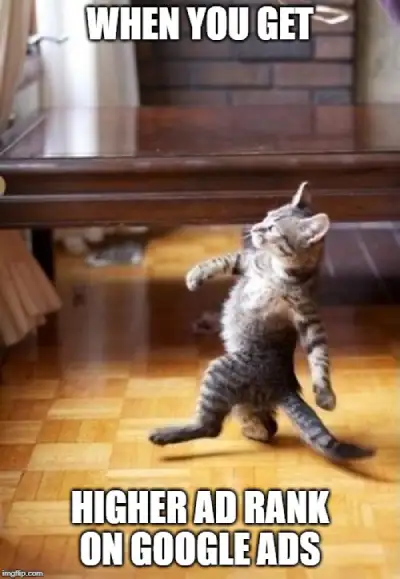
5. What are you paying for?
Google Ads give you the possibility to control how much you will spend on advertising.
There isn’t any minimal rate that you need to spend. You set the daily budget and choose how to spend your money.
Which auction strategy to choose?
As it has already been said, the payment process functions as an auction. You are bidding how much you will pay to Google per click.
It is important to adjust the auction strategy to your goals: would you like more ad clicks, more ad appearances or more conversions (phone calls, inquires, bookings)?
The following auction strategies are available to you:
– Cost-per-click (CPC): determining the rate per ad click. You can choose how much you will pay for each click on your ad. If you want to have more people from the particular social group on your website, this is the right strategy for you.
– Cost-per-thousand impressions (CPM): setting the rate for every thousand appearances of an ad – you are deciding how much you will pay every time your ad is shown for the thousandth time. If it is important for you to have as many people as possible, who will see an ad (no matter if they clicked or not), then choose this strategy. Of course, this strategy is available only for Display ad network. CPM strategy is excellent if you want, for instance, to advertise a newly opened or renovated restaurant and it’s important for you to have as many people informed about it as possible.
– Cost-per-acquisition (CPA): If you want to focus on conversions, choose this model. Conversion means that the visitors have taken some action on your website, and it can be: a filled-in booking form (often in tourism), application for the newsletter, a particular number of website pages that have been viewed, and so on.
Besides this, there are other advanced auction strategies, but these ones are enough as you have just started working with AdWords.
Setting of daily budget
Your daily budget is an amount you want to spend every day, on average, for an advertising campaign. The amount completely depends on you, and you can change it whenever you want.
During bidding, you choose how much you are willing to pay for 1 click, 1.000 appearances or 1 conversion, depending on the bidding strategy that you choose. The costs will vary from auction to auction, but your daily budget sets the limit to the amount of money you’ll spend daily for the campaign.
How much will you pay?
The final amount that has to be paid in the end depends on the auction strategy you use.
If you use CPC or CPM strategy, the amount that you have to pay is not bigger than the one that you need in order to have a higher-ranking ad which will be in front of the advertisers’ right below you.
Example:
Let’s say you want to pay $1.50 per ad click for the particular keyword. However, there are two other auctioneers bidding for that same keyword, one of them pays $1.40 per ad click and another one $1.25 per click. No matter you bid for $1.50 per click, you will pay only $1.41 as this is an acceptable rate in order to be in front of the advertiser who is just below you (with a presumption that all three ads have the same quality).
If you are using CPA bidding, the final amount can be higher than your amount during the bidding, as it also depends on some factors that Google cannot change. However, if you use this strategy, the system will adjust, so it won’t be a common situation in which you have to pay more than what you have bid. You need to be patient with this strategy.
I hope that this post will be helpful for you and your travel business.
To start with Google Ads just visit https://ads.google.com
But if you don’t have time to deal with all of this do not hesitate to contact us. We will improve Google advertising performance for your hotel, apartments, or tours.
We own official Google Ads certificates and we have a lot of experience with travel industry clients and their Google ads accounts.
Do you use Google ads in your travel advertising, what are your experiences and effects? Do you have any questions? Write us in comments, we would be happy to respond. 🙂
